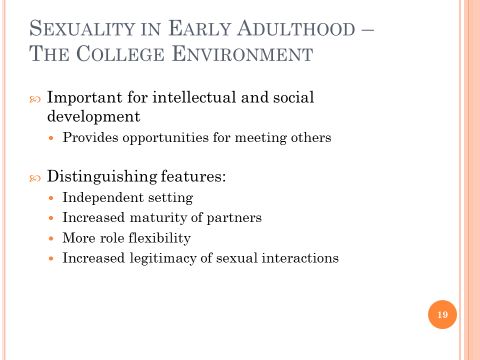Table of Contents
- Sexuality in Childhood , Adolescence, & Early Adulthood Chapters 6 & 7
- Main Topics
- Sexuality in Childhood and Adolescence (Chapter 6)
- Infancy and Sexual Response (Ages 0 to 2)
- Childhood Sexuality (Ages 3 to 11)
- Childhood Sexuality (Ages 3 to 11) - Generalizations of Expressing Affection
- Sexuality in Adolescence (Ages 12 to 19)
- Physical and Hormonal Changes During Puberty
- Sexuality in Adolescence (Ages 12 to 19)
- Sexuality in Adolescence (Ages 12 to 19)
- Sexuality in Adolescence (Ages 12 to 19)
- Sexuality Education
- Sexuality in Adulthood (Chapter 7)
- Sexuality in Early Adulthood
- Sexuality in Early Adulthood
- Three Models of Sexual Orientation
- Sexuality in Early Adulthood
- Sexuality in Early Adulthood - New Social Context of Singlehood
- Sexuality in Early Adulthood - The College Environment
- Sexuality in Early Adulthood - The College Environment
- Sexuality in Middle Adulthood
- Sexuality in Middle Adulthood
- Sexuality in Middle Adulthood
- Sexuality in Late Adulthood
- Sexuality in Late Adulthood - Stereotypes of Aging
- Sexuality in Late Adulthood
- Sexuality in Late Adulthood
- Final Thoughts
Text and Images from Slide
Sexuality in Early Adulthood - <br />The College Environment
- Important for intellectual and social development
- Provides opportunities for meeting others<br />
- Distinguishing features:
- Independent setting
- Increased maturity of partners
- More role flexibility
- Increased legitimacy of sexual interactions
19
